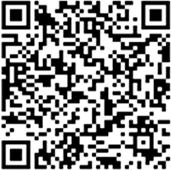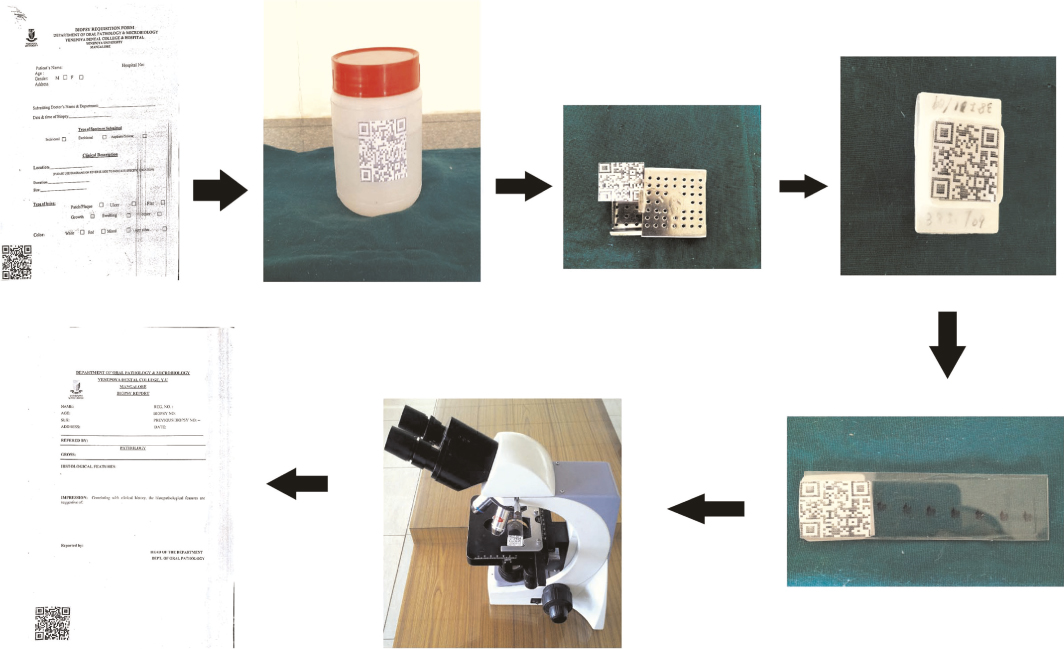Yencode – its application in dentistry
Moidin Shakil, MDS1, Karteek Durbakula2, Kulkarni Spoorti2, Maji Jose, MDS1
1Department of Oral & Maxillofacial Pathology, Yenepoya Dental College, Mangalore, Karnataka, India; 2Post Graduate Student, Department of Oral & Maxillofacial Pathology, Yenepoya Dental College, Mangalore, Karnataka, India
Corresponding Author: karteek.durbakula@gmail.com
Journal MTM 4:2:48–50, 2015
Quick Response Codes are used in modern day lifestyle for various purposes. Yencode (QR Code) is an innovative approach in recording and maintenance of slide details. Having an access to slide information from any part of the world with mobile QR Code scanner software will enable in early diagnosis and effective treatment. Yencode is a boost to retrospective studies as it saves a lot of time and problems encountered in recollecting old details and minimizes manual efforts in retrieval of information.
Introduction
Quick Response (QR) Code is a two dimensional barcode invented in 1994 by the Toyota Motors subsidiary Denso Wave to track vehicles and parts during the manufacturing process. The QR Code consists of black square dots arranged in a square grid on a white background. The information encoded may contain data consisting numeric, alphanumeric, byte / binary, Kanji. (Figure 1). A QR Code is read and decoded by an imaging device, such as a camera, mobile phone, red laser, barcode scanner and QR scanner.1

Figure 1: QR Code showing title and author names.
QR Code can store varied amounts of data depending on mode, version and error correction level. Mode refers to the input data type like Numeric [Max. 7,089 characters (0,1,2,3,4,5,6,7,8,9)], Alphanumeric [Max. 4,296 characters (0-9, A-Z {upper-case only}, space, $,%,*,+,-,.,/,:)], Binary [Max. 2,953 characters (8-bit bytes)], Kanji [Max. 1,871 characters]. Version indicates the dimensions of the QR Code which ranges from a minimum size of 21×21 modules (version1) to a maximum size of 177×177 modules (version 40). Error correction indicates the percentage of distortion which can be restored. Four error correction levels are present for QR Codes [Low (7%), Medium (15%), Quality (25%), High (30%)]. The maximum data storage capacity occurs at version 40 with error correction level ‘L’.2 QR Code has the advantage of smaller printout size, high speed scanning and can be recognized correctly even if half of the areas of barcode are damaged.3
Slides are being used for various retrospective analyses done in histopathology. Difficulties are encountered in maintaining records containing the case history, biopsy report for long term preservation and lot of time is wasted on searching records pertaining to the same. So we describe here an innovative approach to record these details using QR Code which can be read and decoded by a mobile. We call this method as Yencode.
Mobile phones are the most widely used devices in the world. Smartphone is a term used to characterize a mobile phone with special computer-enabled features. Most smartphones are now equipped with integrated cameras that can be used to read visual codes, like Quick Response (QR) Code. QR Codes can be decoded using mobile phones equipped with a camera and appropriate scanner software. Most of the Android mobiles are equipped with a pre-installed QR Code scanner in them. These QR Code scanner softwares are easily available online.4
In medicine, QR Codes are being used for patient identification by printing it on patient wrist band, which encodes for information like patient’s name, identification number, date of birth, sex, ward and bed numbers.5 QR Codes are given by physiotherapist to the patient for postoperative physical exercises which provides access to multimedia sources on the web that contain video demonstrations of the exercises, or some additional suggestions for a good recovery.6 QR Codes are used in blood test process management by marking the test tube with it and are inserted into the tester. The system automatically examines the inserted blood.7
In dentistry, QR Codes are used in the dental assisting clinic for tray setup guide for procedures like minor surgeries like impaction, flap surgery and RCT. QR Codes present on surgical instruments are used to identify devices in order for better management and to contribute to patient safety. Protocol followed for the Yencode is described below (Figure 2)
STEP 1: QR Code (QR1) is generated as soon as the biopsy specimen reaches the lab with case history details incorporated in it using QR Code generator software.
STEP 2: The generated QR Code (QR1) has to be attached to the case history form, bottle containing specimen, cassettes containing the grossed specimen, embedded block and the slide.
STEP 3: After the interpretation of the slide, another QR Code (QR2) is generated with biopsy report incorporated in it which will be attached to the biopsy report form and the reverse side of the slide.
STEP 4: The QR Codes can be stored in the computer or on a paper for documentation and can be sent to the patient through email or mobile.
STEP 5: These QR Codes are decoded with mobile using QR Code scanner software.

Figure 2: The Yencode protocol showing QR Codes on case history form, specimen bottle, cassette, embedded wax block, slide and biopsy report.
QR Code (QR1) which encodes for the case history attached to the case history form, specimen bottle and embedded block helps in the identification of the specimen and block during retrospective studies. Slide containing both the QR Codes (QR1, QR2) helps not only in the identification of the slide but also provides the case history and histopathological report of the particular slide.
Merits
The approach using Yencode enables to have both case history and biopsy report coded and scanned on either side of the slide and facilitates retrospective analyses for the pathologist. Yencode also helps the patient by providing easy access to the biopsy report through mobile using QR Code scanner. Yencode decreases paper work and reduces manual effort in maintaining and retrieval of the histopathological records.
Demerits
Lack of familiarity of Quick Response Codes and smart phones with QR Code scanner softwares limits the usage of Yencode. Incorporation of histopathological pictures in the QR Code is not possible which can be done with the advanced versions in the future. Several researchers believe that the privacy and confidentiality are at stake using QR Code. This can be overcome using Security QR Code (SQRC) which provides password protection for the QR Codes.
Applications in Dentistry
QR Codes can be used to maintain case records, to code radiographs, to print codes on IOPA covers which encode case history and radiographic interpretation. QR Codes will be useful to maintain community dentistry case records and in follow up record maintenance. In Prosthodontics, QR Codes can be used for recognition of casts and dentures. Tooth eruption patterns and tooth movement details can be updated using QR Codes. QR Codes will be useful in setting up a digital museum. Dental material composition information & methods of material manipulation, stepwise guidance to procedures such as impression making and cavity preparation can be encoded in QR Codes which will help in undergraduate teaching in institutions.
Conclusion
Yencode, a new approach in histopathology, should be practiced in order to facilitate long term retrospective studies which saves a lot of time, by electronically recording the details, and provides ease of accessibility from anywhere in the world through mobiles, maintaining confidentiality of report information. Several offline and online softwares are advanced at aiming rapid progress in retrospective research in order to decode diagnostic dilemmas. Innovatively translating modern oral pathological practice is the need of the hour.
References
1. Sahu SK, Gonnade SK. QR Code and Application in India. International Journal of Recent Technology and Engineering 2013;2(3):26–8.
2. Sharma V. A study of malicious QR codes. International Journal of Computational Intelligence and Information Security 2012;3(5).
3. Chuang JC, Hu YC, Ko HJ. A Novel Secret Sharing Technique Using QR Code. International Journal of Image Processing 2010;4(5):468–75.
4. Vazquez-Briseno M, Hirata FI, Sanchez-Lopez JD, Jimenez-Garcia E, Navarro-Cota C, Nieto-Hipolitoet JI, et al. Using RFID/NFC and QR-Code in Mobile Phones to Link the Physical and the Digital World. Interactive Multimedia. Dr. Ioannis Deliyannis, (Ed.) InTech (2012): 219–42.
5. Soon, T. J. The QR Code – Section three. The Synthesis Journal 2008:59–78.
6. Kubben LP. QR codes in neurosurgery. Surg Neurol Int 2011;2:104. ![]()
7. Garcaí-Betances RI, Huerta MK. A review of automatic patient identification options for public health care centers with restricted budgets. Online Journal of Public Health Informatics 2012;4(1):1–16.

